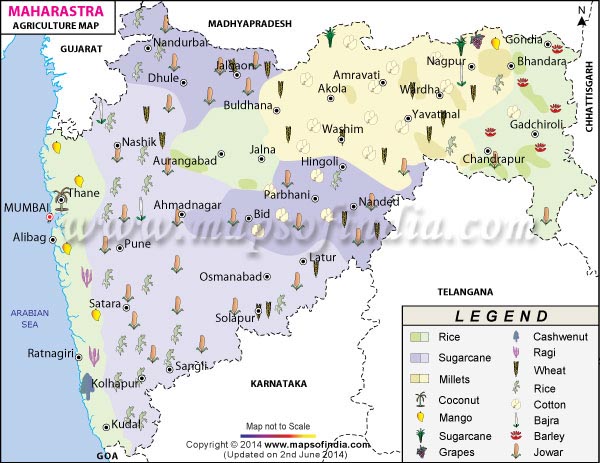Topography and the geology of the region is such that groundwater resources are limited and in groundwater rich areas, over-extraction of groundwater has been observed with emphasis on cash crops such as sugarcane, bananas, grapes, and oranges.
The total irrigated area which has been used for crop cultivation is 33, 500 square kilometres; that makes it to only 18 per cent of Gross Cropped Area. Cashing in on its strengths, Maharashtra state has been focussing on high-value Horticulture rather than staple crops. Large areas of the state have been brought under fruit and vegetable cultivation which present tremendous export potential and have added to the treasury of the state. Agri Export Zones have been developed to market the produce. In recent years Maharashtra has become the largest producer of Onions (63%), Banana (75%), Mandarin oranges(75%), Tomatoes(42%), Pomegranates, Alphonso Mangoes (90%) and seedless grapes (78%). The state leads the sugar industry sector with about 150 productive cooperative sugar mills.
Maharashtra is the first state to adopt 'Dry Land Farming Technology' with the mission to help its farmers. Farmers are being trained on the new techniques for farming, pond irrigation, micro irrigation, inter-cropping, double cropping, etc., in addition to providing them with improved short duration yield seeds, fertilizers, pesticides etc, This technology transfer from the 'Agricultural Universities' to the farmers is evident from the high yields.
The state is also a pioneer in co-operative water user associations; it stands first in the country with more than 60% of the area under drip irrigation. Efficient management of rain water and soil conservation is done to boost agricultural production from dry lands.
The agricultural growth rate has increased to 1.97%. To make things more accessible to the farmers the interest rate for the loans has been decreased to 6%. A very important problem is the dependence on rainfall. To lessen the dependence irrigation facilities have been extended to an additional area of 1.4 lakh hectares. To provide relief to stressed farmers who have been affected by the drought conditions, Rs.5200 crore has been sanctioned by the central government. This has been done to six districts of the Vidharba region. To compensate the crop losses Rs367 crore has been granted to the poor farmers. Apart from that stringent actions have been taken on 2821 illegal money lenders.
Research on agriculture and agricultural products needs to be conducted to tackle the diverse agro - climatic differences. Apart from that the transport and communication services, infrastructure development in the rural area has helped in developing the agricultural production of the state.
Last Updated on : November 13, 2025
|
|
